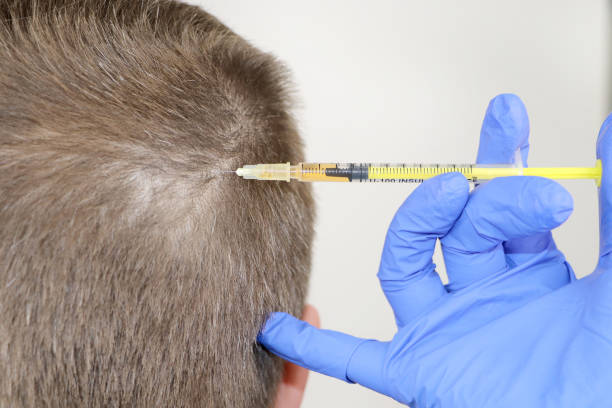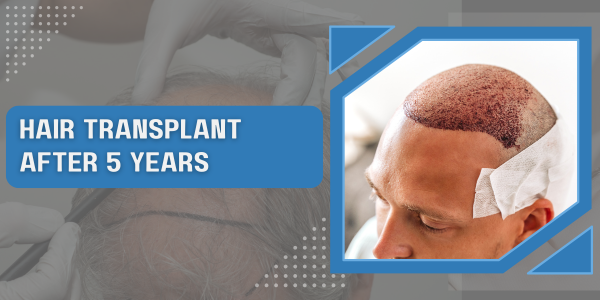A hair transplant is a life-changing decision — one that brings not only new hair but also restored confidence. However, many people begin to wonder: what happens 5 years after a hair transplant? Are the results still natural? Do you need another session?
Dr. Archit Aggarwal, a renowned dermatologist in Faridabad, has helped thousands of patients regain their hair and confidence. With years of experience in advanced hair restoration techniques, he offers clear insights into the long-term outcomes of a hair transplant.
What to Expect 5 Years After Hair Transplant

If your transplant was done using modern techniques like FUE or FUT under a qualified expert, you will be pleased to know that the 5 years post-transplant results are often stable and aesthetically pleasing. Here’s what you can generally expect:
Improved hair growth and maturity
By year five, the transplanted hair has fully matured. The growth cycle stabilizes, and the hair strands resemble your natural hair in texture and thickness.
Natural appearance
Transplanted hair tends to blend seamlessly with the native hair over time. A well-performed procedure ensures natural hairlines and density, eliminating any “pluggy” appearance.
Durable results
Hair follicles transplanted from the donor area (usually the back of the scalp) are genetically resistant to DHT, the hormone responsible for hair loss. This means the results often last a lifetime with proper care.
Lifestyle impact
Most patients by year five don’t even think about their transplant anymore. It becomes a part of their lifestyle, requiring only basic hair care.
Worried about hair transplant result? Book a consultation with a trusted dermatologist for natural-looking, long-lasting results.
Are you experiencing issues after 5 years? Here’s what might be going on.
Side Effects and How to Manage Them
While most people enjoy long-lasting, worry-free results, some may encounter late-onset side effects. It is important to be informed so you can act early.
Shock loss in native hair
This isn’t about the transplanted hair falling out — it is the natural hair surrounding the transplant area that might thin over time. If untreated, this can affect overall density.

Management: A follow-up with your dermatologist is necessary. Treatments like PRP therapy or topical minoxidil may help retain native hair.
Scalp sensitivity or itching
Some individuals report occasional itching or tightness in the scalp even after years.
Management: A good scalp care routine, anti-dandruff shampoos, and dermatologist-recommended serums can resolve this.
Genetic hair loss progression
Hair transplant doesn’t stop genetic hair loss. While the transplanted hair stays, the rest of your scalp might continue to thin.
Management: Preventive care is essential. Medications like finasteride or minoxidil and treatments like PRP can slow down future hair loss.
Wondering if one session was enough? Here’s how to decide.
Do You Need Another Hair Transplant After 5 Years?

It depends. Many patients maintain great results with a single session, but some may require a second procedure due to:
Progressive hair loss
If your original hair loss pattern wasn’t stable at the time of your first transplant, your native hair may continue to thin, leading to visible gaps around the transplanted areas.
Inadequate density
Some people opt for a touch-up transplant simply to add more density, especially if they were conservative during their initial session.
Aging and changes in hair texture
Aging naturally affects hair volume and texture. A second procedure might be considered to maintain youthful density.
Before deciding, consult an experienced dermatologist like Dr. Archit Aggarwal, an expert in hair transplant in Faridabad, who can assess your scalp and recommend the most suitable approach.
Thinking about a second session? Schedule a consultation with a dermatologist for guidance and personalized assessment.
Read on to know how to maintain the hair density.
Maintenance Tips for Hair Transplant After 5 Years

Even though your transplanted hair is permanent, it still needs attention to maintain optimal appearance. Here’s how you can take care of it:
Regular scalp hygiene
Use a mild, sulfate-free shampoo to keep the scalp clean. Avoid over washing and harsh chemicals.
Balanced diet
Hair health begins from within. Protein-rich foods, biotin, omega-3 fatty acids, and zinc support long-term hair strength.
Avoid heat and chemical styling
Minimize the use of straighteners, curlers, and harsh hair dyes. They weaken hair strands over time.
Use hair growth products cautiously
Products like minoxidil can support existing hair but consult your dermatologist before starting or continuing them after 5 years.
Schedule annual checkups
Routine check-ins with your dermatologist help catch early signs of hair thinning or scalp issues.
Protect your results. Schedule a hair health evaluation with a hair transplant surgeon today.
Conclusion
Reaching the 5-year mark after a hair transplant is a significant achievement. With stable results, natural appearance, and manageable maintenance, you can enjoy the benefits of your restored hair with confidence.
However, staying informed and proactive is vital. With expert guidance from a prominent dermatologist like Dr. Archit Aggarwal, your hair journey can stay strong well beyond five years. Whether it’s maintenance, touch-ups, or preventing future hair loss — expert advice goes a long way.
FAQ
Will my hair look natural 5 years after transplant?
Yes, if your transplant was done by a skilled surgeon and you followed post-op care instructions, your hair will appear natural and blend seamlessly with the rest of your scalp.
Can the transplanted hair fall out after 5 years?
Transplanted hair is mostly permanent. However, poor scalp care or medical conditions can lead to some shedding. Regular dermatological checkups help prevent this.
Is it normal to lose density after 5 years?
Some decrease in density can happen if native hair continues to thin. The transplanted hair usually remains intact, but you may notice overall thinning due to genetic hair loss.
Can I dye my transplanted hair?
Yes, transplanted hair behaves like normal hair, so you can dye it. However, it’s best to use mild, ammonia-free colors and consult your doctor if you are unsure.
Do I need to use minoxidil or finasteride forever?
Not necessarily. While transplanted hair doesn’t rely on these medications, continued use can help preserve native hair and overall density. A dermatologist can guide you based on your condition.
Disclaimer: The information shared in this content is for educational purposes only and not for promotional use.

